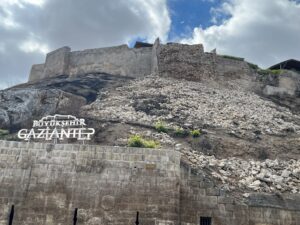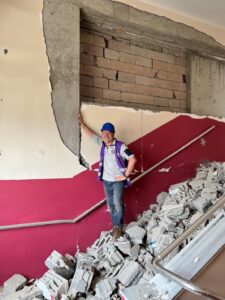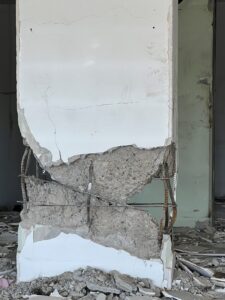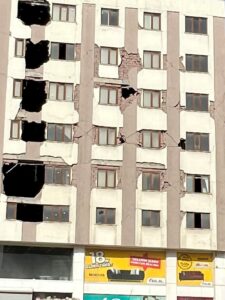
An Engineer’s Account of Assisting in Relief Efforts Following the 2023 Turkey Earthquake
After hearing about the devastation in Kahramanmaraş, Turkey, I felt compelled to join the efforts in assisting the affected region.
The following was written by Hoyt Jeter. This is a first-hand account of his relief efforts in Turkey following the 7.8-magnitude earthquake that struck the region on February 6, 2023.
The middle eastern countries of Turkey and Syria are precariously situated upon and between three highly active tectonic plates – the Anatolian (which underlies much of the two countries), the African (to the south) and the Arabian (to the east).
On February 6, 2023, a left lateral strike-slip between two faults resulted in a massive 7.8 magnitude earthquake (followed by a second 7.5 magnitude earthquake) that was felt throughout the region. The one-two punch of these earthquakes proved catastrophic, with tens of thousands of lives lost and even more injured.

After hearing about the devastation in Kahramanmaraş, Turkey, I felt compelled to join the efforts in assisting the affected region. As a professional engineer and the Senior Structural Plan Reviewer for the City of Tacoma, I was confident that my knowledge and experience could be put to good use.
My experience in Kahramanmaraş was both sobering and enlightening. Together, with my colleagues at All Hands and Hearts, we exemplified the spirit of international cooperation and solidarity in times of crisis as we worked towards restoring hope and stability in the region.
All Hands and Hearts
Locally, the Structural Engineers Association of Washington (SEAW) asked for people to be ready to go if Turkey, specifically Kahramanmaraş, needed us to do evaluations.
The local government didn’t want outside help, but a program was already in place, and volunteers were needed. As a member of All Hands and Hearts, I embarked on a month-long mission to lend my expertise and support to the local community.
All Hands and Hearts is a volunteer-powered nonprofit that addresses the immediate and long-term needs of communities impacted by disasters around the world. The mission of our collective members is to support and assist affected communities, help them recover and rebuild and contribute to the resilience and recovery of communities facing adversity.
Alongside my colleagues at All Hands and Hearts, I was able to lend my expertise, inspect damaged buildings and actively participate in crucial activities such as constructing a portable school, even as we provided much-needed, immediate aid to displaced individuals.
Initial Relief Efforts in the Aftermath of the Turkey Earthquake
Upon arriving in Kahramanmaraş, I was greeted and escorted to the campsite that would become my home for the next month. After orientation and training, we began aiding locals who were grappling with the damage caused by the earthquake.
One of our primary tasks was constructing a portable school to replace the existing one, which had sustained excessive damage. This critical project was not completed when I left, but the main frame was securely in place. It was heartening to witness education continuing despite the destruction, and by providing a safe learning environment, we aimed to help restore a sense of normalcy and hope for the future.
Another task was to package food for locals who were displaced from their homes. We also helped prepare small living spaces for the residents whose homes had been destroyed or rendered unsafe for occupancy. This effort was much needed, as it provided relief from the tight quarters of the makeshift tents in which they had been temporarily sheltered.
Yet another crucial function of our team involved packing donations to be distributed to displaced individuals in the area. We carefully sorted and organized the essential supplies (such as shirts, shoes, socks, pants and baby clothes) and ensured that those most affected received the requisite assistance for meeting their basic necessities.
Additionally, we constructed tents for storage, which enabled efficient management and accessibility of donated items.
Through the Eyes of an Engineer
Disconnected Walls and Improper Stair Systems
While conducting inspections of the earthquake-damaged buildings in Kahramanmaraş, I noticed many of the buildings had concrete floors with walls around the perimeter made of lightweight masonry blocks. One intriguing observation was that the top of the walls appeared disconnected from the top of the floor or roof structure.
This design feature became a concern when subjected to seismic forces, as the walls tended to shift from their normal planar positioning. With only the bottom acting as a cantilever, the walls were exposed to extreme forces and were prone to failure in out-of-plane loading.
In addition to the disconnected walls, I recognized a significant failure between the floor and the attachment of the stair wall in one of the schools. According to the American Society of Civil Engineers (ASCE) 7 standard, means of egress, such as stairs and their connections, must be designed with a safety factor of 1.5. In this case, under dynamic earthquake loading, both levels experienced enough stress to cause the stair system to collapse.
Incorporating proper design measures, as well as implementing the applicable code requirements and safety factors, would have significantly improved their performance during the earthquake. Ensuring a secure connection between the walls and the floor or roof structure, while implementing reinforced supports for the staircases, would have mitigated these failures and enhanced overall structural integrity in many cases.
Column Failures
I observed another notable feature related to column failures of earthquake-damaged buildings. In many instances, the ties, which are horizontal reinforcing bars encircling the vertical bars within the columns, were spaced farther apart than recommended in the American Concrete Institute (ACI) code. This inadequate spacing, ostensibly the main reason for the buckling of vertical bars in the concrete column, contributed to the failures I observed.

Proper spacing of ties within columns is crucial for reinforcing their structural integrity, especially under seismic forces. The ties serve to confine the vertical bars and prevent their buckling or lateral movement, ensuring that the column can withstand the dynamic loads imposed during an earthquake. However, when the ties are not adequately spaced, the bars become susceptible to buckling and fail to provide the necessary strength and rigidity to perform their intended function.
The consequences of inadequate tie spacing, bars placed incorrectly to develop the reinforcement steel and buckling of vertical bars, are evident in the structural failures I witnessed. The compromised columns were unable to resist the lateral forces induced by the earthquake, leading to significant damage and potential collapse of the affected buildings.
To mitigate such failures in future construction, it is essential to strictly adhere to seismic design codes and standards that prescribe appropriate tie spacing and reinforcement detailing for columns. By ensuring proper tie spacing, adequate confinement of vertical bars can be achieved, enhancing the buildings’ overall structural performance and resilience.
Lessons Learned
These findings highlight the importance of robust seismic design and construction practices, particularly in earthquake-prone regions. By adhering to established codes and standards and incorporating the specific hazards of the area, we can enhance the resilience of structures and safeguard the lives and well-being of those who occupy them.
The February 6th earthquake was one of the most recorded earthquakes on record, which will go a long way in providing information and code recommendations to help mitigate the impact of future disasters.

As a professional engineer and code specialist, it’s my duty to bring attention to these issues and advocate for improved construction practices that prioritize safety and resilience. One crucial aspect of construction, design, inspection and review is that it be conducted independently and without the influence or pressure of outside sources. This is essential to ensure life safety.
By sharing these observations and thereby raising awareness of their inherent dangers, I hope to contribute to the ongoing efforts of promoting more substantial and more earthquake-resistant buildings in Kahramanmaraş and beyond.
Click here to read more about how codes protect against disaster, find disaster preparedness tips and learn more about hazard mitigation for homeowners.






